► Is Land Rover’s aging Discovery still king of the all-rounders?
► A 1200-mile French road trip, with frequent live updates
► Regular diary entries, questions/comments welcome
The Good, the Bad and The Ugly: a fortnight in a Land Rover Discovery
So, after 1210 miles, the Discovery has finished its ultimate family test. Those of you that have followed this roving report over the last fortnight will not be surprised to learn that, rather predictably, the Discovery was absolutely brilliant in the areas where you would expect it to be strong, and weak where it wasn’t. But there were some surprises along the way. Here’s our executive summary.
The Good
The Land Rover was a superb companion. Comfortable, spacious and capable, it covered 1200 miles without breaking sweat. It felt safe and soothing, imbuing all on board with a real sense of security, comfort and wellbeing. Combined with the Thule bike rack and roof box, it swallowed everything we threw at it. The flexibility of its seating arrangement, the intelligently configured storage areas, the high levels of visibility – everything felt perfectly geared towards dealing with the idiosyncrasies, frustrations and challenges of moving families in comfort and safety.
The Bad
To misquote James Carville, it’s the fuel economy, stupid. While the 3.0-litre V6 diesel delivers enough tail-up performance to successfully mask the Discovery’s kerbweight, helped by an exceptionally smooth and intuitive eight-speed automatic transmission, it consumes a vast amount of fuel in the process. Yes, I didn’t help matters by strapping four bicycles and an aerodynamic roof coffin to the Discovery, but economy hardly improved when shorn of this extra weight and bulk, rising from 25mpg to – wait for it – 27.5mpg. Ok, I might have driven it like there was a litre of nitroglycerine in the boot at times, but it’s still a pretty thirsty car.
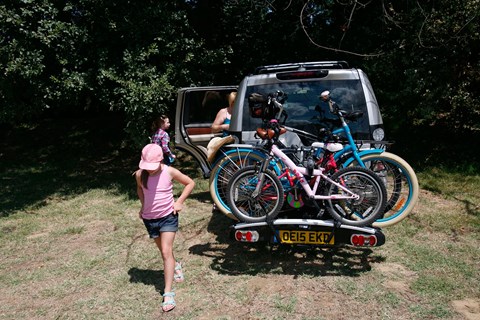
The Ugly
The Land Rover’s infotainment technology looks and operates like something out of Bill Gates’ garage, circa 1973. Everything you need is there – satnav, DAB radio, thumping sound system – but I found accessing and using it a lesson in patience and persistence. By comparison, the system fitted to our year-old Seat Alhambra is a paragon of speed, clarity and intuition – fewer buttons, larger screen, greater tactile intelligence.
The Verdict
Is the Discovery the best family car on the market? Well, yes. And no. It depends on your perspective and how you define the concepts of ‘best’ and ‘family car’. A number of your informed and well-aimed comments have derided the Discovery for lugging around expensive and heavy all-paw hardware that is rarely if ever used. It’s a valid point – without its sophisticated go-anywhere drivetrain, the Discovery would be lighter, more economical, more engaging to drive and cheaper. All upside, until you actually need that four-wheel drive ability.
The Landie’s go-anywhere-anytime ability may not be put to the test on a regular basis by a number of drivers, but knowing it’s there to be called on when needed is a great confidence booster. And a very effective marketing tool, to boot. A bit like those waterproof-to-one-hundred-metres-anti-magnetic-satellite-tuned watches: expensively over-engineered for timing your child’s egg and spoon race on sports day, but reassuring all the same. Feelgood factor is difficult to define, easy to recognise and expensive to attain, as most Discovery drivers will tell you.
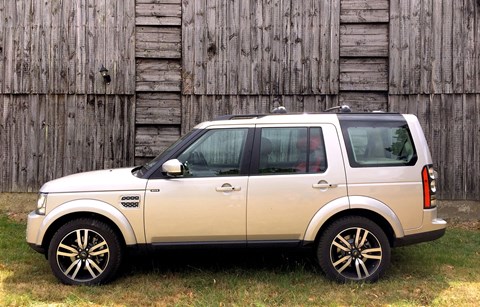
Update 4: our wishlist for the next-gen 2017 Land Rover Discovery
After driving the Disco for more than 1000 miles on a European road trip, I’ve had ample chance to appraise the family Land Rover. Given the final touches are probably being applied to the next-gen Discovery as we speak, my list of D5 must-haves, below, is probably a tad late. But here’s hoping…
1) Lightweight construction
A given this, but it’s the singularly most important aspect of the next-gen Discovery – it needs to pull off an Alison Moyet-style weight loss programme. The current model lumbers up to the scales at a hefty two and half tonnes – that’s 500kg more than the new, seven-seat XC90. Let’s hope big doesn’t have to mean heavy, and that the next Disco wows us with hybrid construction and the abundant use of aluminium, ultra high-tensile steels and composites.
2) Sliding rear doors
Controversial, I know, but until you have children, you have no idea how difficult it is to get small folk in and out of the back, particularly given the width of the Discovery and seemingly ever-narrower parking bays. The sliding doors on our Seat Alhambra were the main reason we purchased it – that and it being better equipped and cheaper than the equivalent Sharan. Now Land Rover’s Discovery Vision concept that previews the new model has gone all swoopy and sleek, much like the Disco Sport, but if you look at the angles of the C- and D-pillars, their symmetry suggests… well, who knows. Sliding rear doors that open up the cavernous rear for easy access to the two rows of rear seats… makes sense to me!
3) Smart all-wheel drivetrain
I’m basing this on an intelligent guess, but I imagine that 95% of Discoverys spend 95% of their time on the road, and only infrequently call on its formidable off-road capabilities. I also know that the Landie’s go-anywhere ability is a key part of its DNA, as effective at digging it out of difficult terrain as it is a marketing tool. It’s not to be mucked about with. But for standard day-to-day driving, a highly efficient all-wheel drive system that lets the front wheels do much of the work and calls on the rear wheels as and when needed would significantly enhance economy, without compromising the integrity of the Discovery’s go-anywhere ability.
4) Smaller hybrid engine
While the creamy and expensive-sounding bi-turbo V6 under the current car’s clamshell bonnet delivers the goods, that’s the only powerplant available. A missed trick when rivals like Mercedes-Benz, BMW and Volvo offer a wider engine choice. A significantly lighter model would require a smaller and lighter four-cylinder engine, creating the opportunity for a far wider line-up of four- and six-cylinder models. More models equal broader appeal equal more sales. Or LR could ditch the expensive and heavy six-pot engines entirely and opt for a hybrid unit, with zero-emission electric drive for low-speed urban work, and a variable combination of diesel-electric power for motorway work. Plenty of torque at zero revs is not without its appeal when it comes to off-road work… We’ve seen similar plug-in tech on the Range Rover Hybrid.
5) Real life, not lifestyle
The straightforward utilitarian functionality of the Discovery is refreshingly honest in today’s lifestyle-spun marketing world. I hope that purity of function, that unerring understanding of what matters to real people in the real world, isn’t lost through evolution. Those drivers wanting a dash more carpark kudos are well served by the sleek and snappy Discovery Sport, but I’ll be bitterly disappointed if the next Discovery is simply a 120% carbon copy of the Sport.
I’ll be updating this feature regularly during our European road trip, and you can also follow me on Twitter @benwhitworth using #cardiscovery. Questions and comments most welcome…
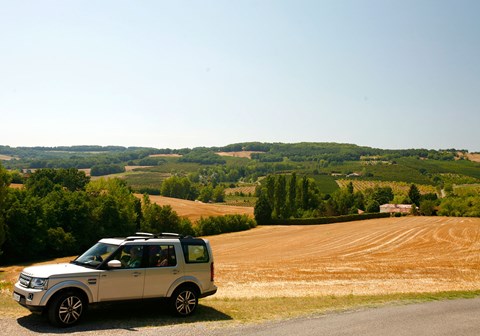
Update 3: driving a Discovery to the south of France
So, we’re a week and 700 miles into our French road trip by Land Rover Discovery. As before I’ve jotted down my comments from the onboard notebook. In no particular order then…
Driving a Discovery imbues you with a real sense of capability. In a family estate or saloon you’d drive through the beautiful Aquitaine countryside and marvel at the endless orchards, vineyards and field after field of sunflowers. In a Discovery, you know you could swing the steering wheel hard left or right and take a sure-footed excursion over pretty much anything between you and your destination. You drive with the equivalent of a confident big-balled swagger. It’s not quite automotive omnipotence, but it comes pretty bloody close.
Removing the Thule roofbox and bike rack has put a spring into the Discovery’s step. As well as being a little more eager both off the mark and on the go, the cabin is now also quieter. And fuel economy has rocketed to… erm… 27.5mpg. Maybe I need to recalibrate my internal fuel gauge, but something about not being able to crack 30mph still rankles. I think the old adage that if you can afford to buy it you can afford to run it must stick in the craw of most Discovery drivers every time the 82-litre fuel tank needs refilling.
The sundial speed of the sat-nav still irks – the navigation on my iPhone is light years ahead in both user interface and speed – as does its tiny screen and teletext graphics. It shows how the speed of technology effortlessly outpaces chunks of metal, glass and plastics. Speaking of pace, the Discovery doesn’t like to be rushed. With its waterbed ride quality, laissez-faire body control and thick-ankled kerbweight, pushing the Land Rover along meandering French roads is not exactly rewarding. But waft along, taking full advantage of the excellent visibility from the elevated driving position and letting the buttery-smooth, eight-speed ‘box keep you near the 2000rpm torque peak, and the Discovery covers ground with an effortless insouciance.

Rather than faff about with headlight stickers to ensure the Discovery’s piercing bi-xenons (part of the £740 optional Vision Assist Pack) don’t blind oncoming drivers, you simply scroll through the onboard electronic menu, select the ‘driving on the right’ option for the adaptive lights and you’re away. Neat. But nowhere near as neat as the line drawing of a Discovery that’s beamed down onto the ground at night from the puddle lights housed in the door mirrors (above).
It’s taken a while to grow accustomed to the Discovery’s outsized dimensions and lofty driving position, but I now relish its commanding view of the road, the high-riding stance and its low-key status. It’s nowhere near as vast and ostentatious as a Range Rover or as sleek and urbane as the Discovery Sport – it’s all about form following function. And I like the form.
The Discovery is certainly starting to show its age in the areas you’d expect, but taken as a whole, it still feels terrifically competent and cogent. Like a Swiss army knife, the Discovery is defined by its functional intelligence, its resourcefulness and its proficiency.
Update 2: Chichester to Le Mans by Discovery
We’ve travelled 600-odd miles over the last two days, from Chichester to Portsmouth, over the Channel to Caen, then down to Le Mans to over night before heading southwest towards Bergerac and Agen. Plenty of time to get under the Discovery’s skin. So, in no particular order, here are my thoughts and observations.
The grunty 2993cc turbodiesel engine does an admirable job of camouflaging the Discovery’s obese 2504kg kerb weight. At 2000rpm a plentiful 516lb ft of torque arrives at the party and gets things going. It sounds lovely too – smooth, bassy and purposeful. The eight-speed ‘box is an ideal companion for the engine. It shifts gears smoothly and cleanly, responding quickly and unobtrusively to throttle inputs. Intergalactic gearing means it’s pulling 1600rpm at 70mph in eighth. And I particularly liked dropping into Sport and using the paddle shifters for manual control.
I forgot how soft and roly-poly the Land Rover’s ride quality is – it shares a lot in common with Brittany Ferries’ Normandie that sashayed us across the millpond-smooth Channel from Portsmouth to Caen. Big, heavy, solidly constructed and capable of swallowing vast amounts, the Discovery is at its best in a straight line on smooth roads where its sheer weight can steamroller any intrusions into submission. But tiller it into a bend and even at low speeds it rolls and leans quite dramatically. It’s initially disconcerting until you realise that once it’s leaning, it hangs on like billyo.
The last time I drove a Discovery was in 2004 when the 3 was launched. It was big then and longevity and ubiquity haven’t made it any smaller. I love its commanding driving position and excellent visibility, and I chuckled when my young daughters asked if there a ladder to get in and out of the rear seats. Its vast boot kept swallowing suitcase after suitcase, and there was plenty of space for the four of us and all the cabin clobber you need for a two-day jaunt. But when you’re squeezed like tinned sardines into the hull of a ferry with 650-odd other vehicles, you realise just how awkward its outsized dimensions can be when you can’t open the doors to get in or out.
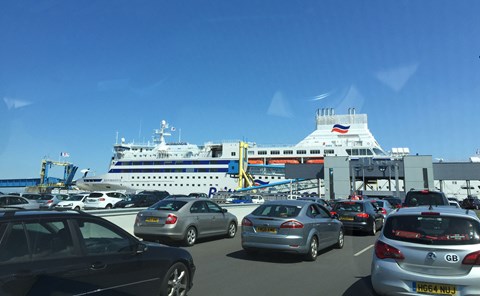
I drove very conservatively down to Bergerac. I adhered to speed limits, feathered the throttle on long downhill runs and accelerated gently away from the tollbooths. But I was still left reeling from the 25mpg figure I recorded. Yes, I had a Thule roofbox and bikerack bolted to the Discovery for family holiday duties, which probably mullered its already iffy aerodynamics and added to its already obese kerb weight… but 25mpg? The next-gen Disco needs a 600kg reduction in kerbweight and an efficient on-demand 4×4 system for motorway work.
The HSE Luxury ladles on the spec, most of it useful and welcome, but the satin-finish wood – particularly on the top half of the steering wheel – jars. It looks more than a little out of place on the chunkily functional cabin architecture. Probably the area that shows up the Discovery’s age the quickest are its sat-nav and infotainment systems. They are woeful. Tiny screen, Lego-block graphics, no central controller and a touchscreen that measures its responses in minutes. In a car nudging £60k? Not good, but the latest Disco Sport shows that a more modern system is waiting in the wings.
We love the absolutely thumping Meridian sound system. Rich, warm and clear, Supertramp and John Mayer never sounded better. Too bad I was outvoted and Miley Cyrus and Miranda Lambert dominated the playlist. Meh.
The rear entertainment system had my two young daughters hugely excited about the possibility of watching Tangled and Frozen rather than having to talk to their parents all the way to Aquitaine. But no matter what method I tried, the system refused to run the videos off a USB stick. Cue sullen faces. It picked Al Jazeera television no problem, though. Odd.
Update 1: the introduction
It’s been a while since we’ve driven the Discovery. Hardly surprising really, when you consider the wave of exciting new metal that has flowed out of Land Rover’s gates over the last few years. There was the Evoque, the current-gen Range Rover, the Range Rover Sport and then the new Discovery Sport, not to mention a raft of hybrid, electric and go-faster variants to fill the gaps.
So we thought it was about time to reacquaint ourselves with the Discovery, the car that we once called one of the most versatile in the world, an amazing jack of all trades if ever we’ve seen one. But that was when it was launched in early 2008. And in the last eight and a half years the automotive landscape has undergone seismic changes. Rivals from BMW, Porsche, Mercedes and Audi have encroached on Discovery heartland, and Land Rover’s responded with a raft of visual tweaks, an overhaul of the cabin and its infotainment technology, a gruntier Jaguar-sourced bi-turbo diesel engine and an eight-speed transmission.
So with retirement, a cheap engraved watch and part-time work at a garden centre not far away, can the Discovery still rightfully claim to be the best family car on the market? Well, rather than get one in to the office for a few days I cheekily suggested a far more rigorous assessment of its skills – the family holiday. A 1200-mile trip to the south of France with children, roof box and bike rack, in other words. So instead of heading to Aquitaine in our new Seat Alhambra, I’ll be packing a Discovery HSE Luxury to the gunwales and seeing how it copes. I’ll be updating this automotive diary throughout our sojourn as well as tweeting using the hashtag #cardiscovery. Questions and comments most welcome. Now to find a French port without burning tyres…
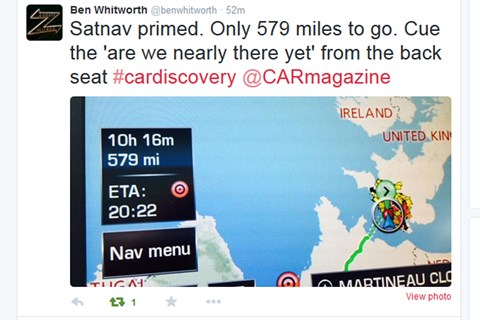

Land Rover Discovery HSE Luxury: vital stats
How much? £59,970
On sale in the UK: Now
Engine: 2993cc biturbo V6, 256bhp @ 4000rpm, 516lb ft @ 2000rpm
Transmission: Eight-speed automatic, all-wheel drive
Performance: 8.8sec 0-62mph, 112mph, 36.7mpg, 203g/km CO2
How heavy / made of? 2504kg/steel
How big (length/width/height in mm)? 4838/1915/1891